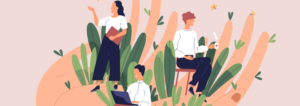Implementing continuous employee listening as a competitive talent advantage
- 5 Min Read
One way, one-off employee feedback doesn’t work for employees or employers. Liz Sebag-Montefiore shares steps for establishing two-way, continuous employee listening that is crucial in addressing employee engagement
- Author: Liz Sebag-Montefiore
- Date published: Aug 4, 2023
- Categories

Good employers embrace a culture that fosters collaboration and communication. The idea is to create a climate where employers do not give performance feedback once a year but instead establish an ongoing process of continuous employee listening that managers use to engage and motivate their employees.
Feedback is an essential component of effective learning. It’s key to how we improve our performance. We must constantly think about how we do and question how we can improve. Meaningful career conversations are not about “correcting” a person’s work. Instead, help your team members see what’s working and share your experience of what the person does well.
Constructive feedback has long been a standard in HR and management training programs. The arguments in favor of candor and transparency and our ability to face criticism are not new. And yet, existing feedback models limit the ability of organizations to gain the advantages of an engaged talent pool.
Continuous employee listening and communication
The traditional performance review, with after-the-fact feedback, doesn’t fit with the way we now work now. It doesn’t work for employers or employees.
Employees want constructive feedback to facilitate performance improvement and personal development. But continuous employee listening is a more useful approach than a tick-box, one-size-fits-all annual review.
This is a process of continued conversation over time which sees performance management for employees evolving organically, rather than as a one-off event that takes place annually. The idea is to work out strengths and what energizes each employee to improve engagement and performance, and to focus on identified areas in an ongoing dialogue.
- What is important to the individual?
- What does the individual like doing and what are they good at?
- Who in their network understands their aspirations and can assist in achieving them?
If you want to see cultural transformation embedded, you need to understand what makes your employees tick: What your top performers do, how your best managers create shared understanding, and how corporate culture drives productivity, innovation, and agile performance in a challenging environment.
Think about employees and how to improve their lives at work to make the organization more effective, collaborative, and creative. The carrot works better than the stick. Positive reinforcement, praise, and encouragement are more likely to inspire and engage than blame, nit-picking, and overdue feedback.
Employee-centered listening
Focus on career discussions that cover what employees need to think about when managing their careers, with the aim of nurturing and developing employees’ skills and confidence. Think about employees and how to improve their lives at work and make the organization more effective.
A real career conversation starts with what is important to an employee, their personal and work values. Use open and probing questions that push the individual to develop their thinking and explore new perspectives.
Employee voice has been linked to outcomes including innovation, job satisfaction, and improved organizational decision-making. Two-way, continuous employee listening is crucial in addressing employee engagement because it gives employees a ‘voice,’ making them active co-authors of their career stories. On a deeper level, regular and better-quality conversations between managers and team members are a simple and powerful way to communicate support from managers and organizations. This is a critical determinant of engagement and a buffer against work-related stress.
Review, reflect, recalibrate, and reframe
Checking in regularly means that organizations deal with employee performance issues promptly. Problems don’t fester and team members can be more confident that they understand the big picture while feeling they have a voice in the process. Performance and productivity improve when feedback is not held back for the annual review and managers deal with issues as they arise.
Offer regular feedback that allows employees to grow and improve, helping them to manage their careers. Employees need feedback to improve their performance and enable personal development but don’t want a retrospective critique of past performance. Offer forward-looking guidance and encouragement that enables a proactive approach to career management.
Aim to facilitate the evolution of performance reviews over time, rather than as a one-off annual event. As a concept, this is in line with research on making the process more relevant and effective. Quality and relevant feedback improve employee learning and task performance. All managers should learn how to deliver effective and constructive feedback.
Continuous employee listening needs continuous improvement
It’s no soft option. These can be challenging conversations. Sometimes, where there is no alignment of values, it may be better for a disengaged employee to move on. Employers must act when it becomes clear an employee is in the wrong role. They must train line managers need to use such conversations to address motivation and engagement with team members and ensure the optimum deployment of resources.
________________
Liz is a Director and Co-founder of 10Eighty, and has provided HR solutions to a wide range of industries since 2005 working with numerous firms to understand their needs. She has over 17 years of experience in the HR consulting world, as a sales director and coach. She is passionate about coaching to motivate individual performance and is committed to coaching people to have successful and fulfilling careers.She’s a great believer in the power and intelligence of networking.










